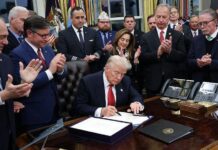(Reuters) – The U.S. government shut down much of its operations on Wednesday as deep partisan divisions prevented Congress and the White House from reaching a funding deal, setting off what could be a long, grueling standoff that could lead to the loss of thousands of federal jobs.
There was no clear path out of the impasse, while agencies warned that the 15th government shutdown since 1981 would halt the release of a closely watched September employment report, opens new tab, slow air travel, opens new tab, suspend scientific research, withhold pay from U.S. troops and lead to the furlough of 750,000 federal workers at a daily cost of $400 million.
Republican President Donald Trump, whose campaign to radically reshape the federal government is already on track to push out some 300,000 workers by December, warned congressional Democrats that a shutdown could clear the path for more job cuts.
Vice President JD Vance issued an unusual warning about air safety, noting that air traffic controllers and Transportation Security Administration personnel — essential staff who work through shutdowns — would be worried about delayed paychecks.
“If you’re flying today, I hope, of course, you arrive safely and on time, but you may not arrive on time because the TSA and the air traffic controllers are not getting paid today,” Vance said on Fox News.
The U.S.’s longest-government shutdown, which stretched over 35 days in 2018-2019 during Trump’s first term, ended in part after flight delays caused by air traffic controllers calling in sick.
Senate Democrats on Tuesday blocked a stopgap measure to fund the government through Nov. 21 over Republicans’ refusal to attach an extension of health benefits for millions of Americans that are due to expire at the end of the year. Republicans say the issue must be addressed separately.
Both sides were posturing to blame the other and looking for advantage in the 2026 midterm elections that will determine control of Congress.
Senate Republican Leader John Thune scheduled another series of votes on Wednesday, hoping to pressure Democrats to break ranks.
WALL STREET SLIPS
The shutdown was set to delay the release of some government economic reports, adding unease to Wall Street investors at a time of economic uncertainty.
Wall Street opened lower, gold struck a record high and Asian stocks wavered as investors worried about delays in the release of key data and the impact of job losses. The dollar hovered near a one-week low versus major peers.
At issue on the government funding front is $1.7 trillion for agency operations, which amounts to roughly one-quarter of the government’s total $7 trillion budget. Much of the remainder goes to health and retirement programs and interest payments on the growing $37.5 trillion debt.
Independent analysts warn the shutdown could last longer than the budget-related closures of the past, with Trump and White House officials threatening to punish Democrats with cuts to government programs and the federal payroll.
“Donald Trump and Republicans have shut the government down because they don’t want to provide healthcare to working-class Americans,” House Democratic Leader Hakeem Jeffries said on ABC’s “Good Morning America.”
Thune said Democrats had routinely backed similar funding bills in years past.
“What’s changed is President Trump is in the White House. That’s what this is about. This is politics. And there isn’t any substantive reason why there ought to be a government shutdown,” the South Dakota Republican told reporters.
Trump’s Republicans hold majorities in both chambers of Congress, but legislative rules require 60 of the 100 senators to agree on spending legislation. That means that at least seven Democrats are needed to pass a funding bill. On Tuesday, three of them voted for the Republican bill.
DEMOCRATS FOCUS ON HEALTHCARE FUNDING
Democrats are under pressure from their frustrated supporters to score a rare victory ahead of the 2026 midterm elections that will determine control of Congress for the final two years of Trump’s term. The healthcare push has given them a chance to unite behind an issue that resonates with voters.
Along with the extended health subsidies, Democrats have also sought to ensure that Trump will not be able to undo those changes if they are signed into law. Trump has refused to spend billions of dollars approved by Congress, prompting some Democrats to question why they should vote for any spending legislation at all.
University of Chicago professor Robert Pape said the polarized U.S. political climate could make it harder for party leaders to reach a deal to reopen the government, which would likely anger their most vocal partisans.
“The rules of politics are radically changing, and we can’t know for sure where all of this is going to end,” he said.



















